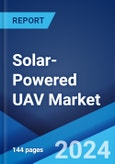Solar-powered unmanned aerial vehicle (UAV) refers to high-altitude pseudo-satellites or drones specially designed to receive power directly from the sun for performing continuous stratospheric operations for a longer duration. It can be operated autonomously without any human intervention even from a remote location by utilizing limitless propulsion systems. It further comprises a range of solar-powered cells that are unified with the vehicle to capture solar energy during the day and generate and recharge the battery on board to provide power in nighttime flights. As compared to traditional UAVs, it offers better stability, higher flight altitude, larger coverage area, and superior load capacity. Along with this, it provides environmental protection, improves employee safety, monitors ecological damages, and minimizes the need for human transportation procedures. As a result, the solar-powered UAV finds extensive application in the surveillance and rescue operations, pollution monitoring, disaster management, attack missions, and intelligence-gathering operations.
Solar-Powered UAV Market Trends:
The increasing demand for drone services for various commercial applications, including resource exploration and climate monitoring, represents a prime factor driving the market growth. In line with this, significant improvements in the military and defense sector and the recent development of UAV drones for asset management and performing dangerous battlefield surveillance operations are acting as another growth-inducing factor. This is further supported by the favorable investments being made by the governments of different nations to enhance their military capabilities. Additionally, the extensive usage of solar-powered UAVs in the agricultural sector over traditional surveying methodologies to analyze crop growth, climatic conditions, spray fertilizers, and track soil conditions is favoring the market growth. Solar-powered UAVs are further employed to assess the ecological damage and active risks, perform weather forecasting, and minimize the adverse effects of potential danger in the mining industry to improve workers safety, which is supporting the market growth. Moreover, the escalating usage of photovoltaic (PV) cells and hybrid-electric propulsion engines to improve the vessel performance at lower maintenance costs is propelling the market growth. Apart from this, significant technological advancements, such as the integration of image-transmitting systems and strategic collaborations amongst key players, are positively impacting the market growth.Key Market Segmentation:
This report provides an analysis of the key trends in each segment of the global solar-powered UAV market, along with forecasts at the global, regional, and country levels from 2025-2033. The report has categorized the market based on type, range, component, mode of operation and application.Type Insights:
- Fixed Wing Drones
- Multirotor Drones
- Quadcopter Drones
Range Insights:
- Less Than 300 KM
- More Than 300 KM
Component Insights:
- Propulsion System
- Airframe
- Guidance Navigation
- Control System
- Payload
Mode of Operation Insights:
- Semi-Autonomous
- Autonomous
Application Insights:
- Defense
- Commercial
Regional Insights:
- North America
- United States
- Canada
- Asia Pacific
- China
- Japan
- India
- South Korea
- Australia
- Indonesia
- Others
- Europe
- Germany
- France
- United Kingdom
- Italy
- Spain
- Russia
- Others
- Latin America
- Brazil
- Mexico
- Others
- Middle East and Africa
Competitive Landscape:
The report has also provided a comprehensive analysis of the competitive landscape in the global solar-powered UAV market. Detailed profiles of all major companies have also been provided. Some of the companies covered include BAE Systems Plc, Barnard Microsystems Ltd, Eos Technologie, Sunlight Aerospace, UAV Instruments S.L, Xsun, etc.Key Questions Answered in This Report
1. How big is the global solar-powered UAV industry market?2. What is the expected growth rate of the global solar-powered UAV market during 2025-2033?
3. What are the key factors driving the global solar-powered UAV market?
4. What has been the impact of COVID-19 on the global solar-powered UAV market?
5. What is the breakup of the global solar-powered UAV market based on the type?
6. What is the breakup of the global solar-powered UAV market based on the range?
7. What is the breakup of the global solar-powered UAV market based on the mode of operation?
8. What is the breakup of the global solar-powered UAV market based on the application?
9. What are the key regions in the global solar-powered UAV market?
10. Who are the key players/companies in the global solar-powered UAV market?
Table of Contents
Companies Mentioned
- BAE Systems Plc
- Barnard Microsystems Ltd
- Eos Technologie
- Sunlight Aerospace
- UAV Instruments S.L
- Xsun
Methodology

LOADING...








